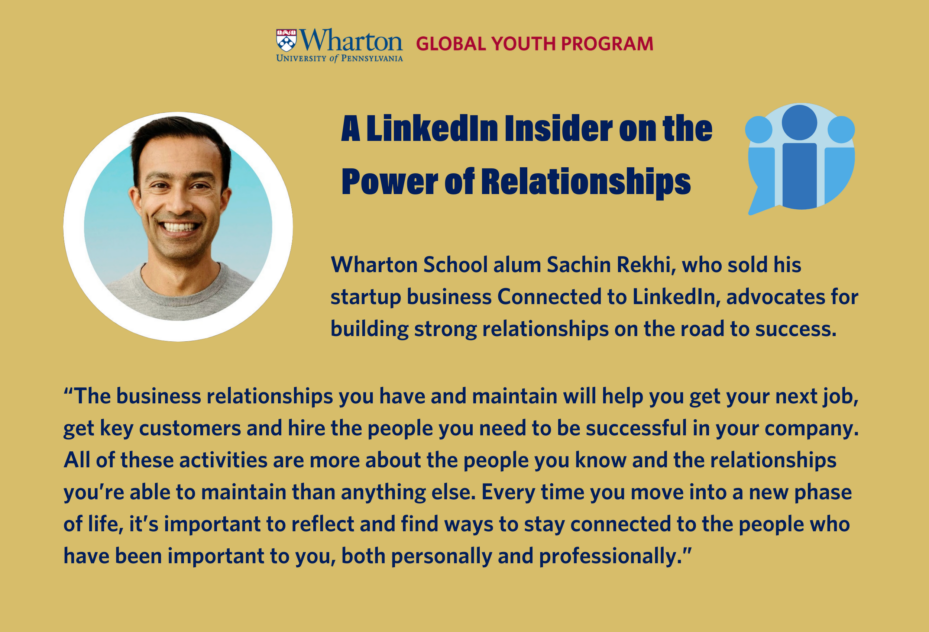High School Business Teachers Share How They Use LinkedIn


In this latest edition of the Wharton Global Youth Essential Educator blog for high school educators, teachers from Global Youth’s Educator Advisory Board share their love for LinkedIn, both as a powerful networking tool for students, as well as a rich source of career inspiration and professional development. Are you on LinkedIn?
Turning 16 is a sweet milestone for many high school students. Such was the case for Ryan S., a student at Smithtown High School West in New York, for an unexpected reason: It meant that he could create his first official profile on LinkedIn, a social media app that has a minimum age requirement of 16.
That profile is a digital résumé, showcasing work and education experience and reflecting personal strengths. You can follow people on LinkedIn and they can follow you – primarily in the professional contexts of work, school and career.

“I use LinkedIn to connect with other students regarding research projects, to expand my nonprofit (FinEdVenture), and simply to grow my network for the future,” says Ryan, who studied in Wharton Global Youth’s Essentials of Finance program in the summer of 2023. “I think an individual’s network is the largest determinant for success, besides hard work and grit, and the ability to create connections with ease on LinkedIn makes these networks abundantly more accessible.”
Wharton Global Youth can confirm that lots of high school students are on LinkedIn, a business and employment-focused social media platform that is often thought of as Facebook for professionals. We see and hear from high school students every day, as they interact with Wharton Global Youth LinkedIn posts and build their own digital presences. Students like Ryan are amplifying their latest successes (Just finished two amazing weeks at the Wharton School of the University of Pennsylvania studying Essentials of Finance!) and using LinkedIn to identify internship prospects, connect with mentors and support their friends’ accomplishments. All the while, their networks grow.
Teachers on LinkedIn
We asked our Wharton Global Youth Educator Advisory Board, comprised of high school business, economics and finance teachers in the U.S., to share their thoughts about the value of LinkedIn for both students and teachers.
Gerri Kimble, a marketing and business management teacher at Hoover High School in Alabama, believes in the power of LinkedIn as a digital-marketing tool.
“By the time our students are seniors, they know how to use LinkedIn professionally,” says Gerri. “A lot of our students have gotten internships and scholarships through LinkedIn. They post about their accomplishments, like competing in DECA, and we help amplify those voices by reposting with our own thoughts. We’ve found as teachers that it helps us to connect with business professionals. All our students complete a 120-hour internship before their senior year. We invite professionals to an internship prep, where they can meet the students and conduct interviews. A lot of times that contact with people in our community begins on LinkedIn. They see how impressive our students are.”
As an active participant in many ways on LinkedIn, Gerri often wonders why more educators are not using the platform. Linda Lowry, an economics teacher at Ramaz Upper School in New York, offers one perspective. “We are not supposed to connect with our students on social media, period,” notes Linda. “I generally won’t do it until after they’ve graduated from college.”
“When it comes to networking, teachers are students’ connection to the real world. Who knows these students academically? It’s us.” -Gerri Kimble, Hoover High School, Alabama
While many school districts have strict policies that prohibit interacting with students on social media, Gerri and her business-education team have the green light to use LinkedIn more broadly because of its professional style. “When it comes to networking, teachers are students’ connection to the real world,” she notes. “Who knows these students academically? It’s us. We play a key role in connecting them with universities and professionals.”
Bringing LinkedIn to the Classroom
Chicago Public Schools are among those with strict rules about communicating online with students, however Kathryn Person, an AP Macroeconomics teacher at Lane Tech College Prep in Chicago, Illinois, suggests that teachers can still prepare their students to use LinkedIn effectively. “Even if we are not their friends on LinkedIn, we can help our students understand LinkedIn’s role and purpose,” says Kathryn. “We can show them what a page looks like and give them some time during class to build their profiles. We can explain how to highlight their skills and how to make connections. It can be part of our career curriculum.”
“I’m absolutely bringing LinkedIn into my economics class,” echoes Ryan Wozniak, a social studies teacher in New York City public schools. “I’m going to highlight it as I would creating a résumé and say, ‘This is the world we live in. You need a LinkedIn profile. Let’s get to it.’”
“I can’t tell you how many times I’ve had alumni email me and say, ‘Hey, do you still have my résumé from last year?’” adds Stephanie Theuret, a business teacher from Pittsburgh Science and Technology Academy in Pennsylvania. “LinkedIn sets them up for that next step. It’s something they can carry with them.”
If you have access to LinkedIn Learning, you can find short quick-tip videos about creating a strong LinkedIn profile HERE. University of Pennsylvania Career Services has also created this useful LinkedIn video.
Connecting the Future with the Past
Speaking of high school alumni, LinkedIn might be just the place to keep in touch with your students after they graduate and become part of their professional networks into college and the workplace. Kathryn has seen this approach pay dividends. “Educators should be on LinkedIn because it builds a network for your current students,” she advises. “I have a high school student who is passionate about theoretical math and is thinking about economics. I reached out to former students on LinkedIn and five of them offered to talk to him about their careers.”
Alex Lamon, a business-education teacher at Livingston High School in New Jersey, just launched a student alumni page on LinkedIn for that very purpose. “It’s an alumni page for our business graduates who went to our high school and are now doing business in real life,” says Alex, who is also executive director of the New Jersey Council for Economic Education. “In a few months, I’ll connect my current Business Honor Society students to this group. It’s a place for alumni to give back. Our students go on to do so many great things after they leave us, and we never talk to them again. I wanted to organize something that would help our Honor Society kids and our senior internship students as they think about the next step.”
The student experience aside, Gerri reminds other high school educators that LinkedIn is also an effective professional-development platform. “We can learn so much from each other,” she says. “LinkedIn has done a lot for me as an educator. Professionals share what they do and blog about best practices. I learn a whole lot about industry. If you’ve not yet used the platform, it’s important to know that it’s way more than connecting, finding jobs and building your résumé. It’s also about staying up to date with industry and what you are teaching about business.”
